Ensemble Fuzzy Feature Selection Based on Relevancy, Redundancy, and Dependency Criteria
Abstract
1. Introduction
2. Relevancy, Redundancy, and Dependency Measures
2.1. Relevancy
2.2. Redundancy
2.3. Dependency
2.4. Example
3. Related Works
4. Fuzzy Feature Selection Based on Relevancy, Redundancy, and Dependency (FFS-RRD)
| Algorithm 1: FFS-RRD: fuzzy feature selection based relevancy, redundancy, and dependency. |
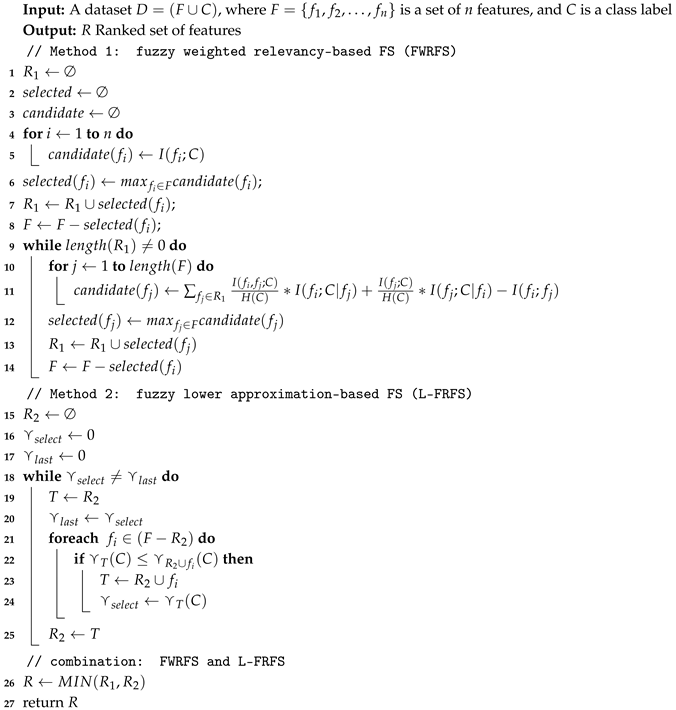 |
5. Experiment Setup
5.1. Dataset
5.2. Compared Feature Selection Methods
5.3. Evaluation Metrics
5.3.1. Classification Performance
5.3.2. Stability Evaluation
6. Results Analysis
6.1. Classification Performance
6.1.1. Accuracy
6.1.2. F-Measure
6.1.3. AUC
6.2. Stability
7. Conclusions
Author Contributions
Acknowledgments
Conflicts of Interest
References
- Macedo, F.; Oliveira, M.R.; Pacheco, A.; Valadas, R. Theoretical foundations of forward feature selection methods based on mutual information. Neurocomputing 2019, 325, 67–89. [Google Scholar] [CrossRef]
- Bolón-Canedo, V.; Alonso-Betanzos, A. Ensembles for feature selection: A review and future trends. Inf. Fusion 2019, 52, 1–12. [Google Scholar] [CrossRef]
- Lee, S.; Park, Y.T.; d’Auriol, B.J. A novel feature selection method based on normalized mutual information. Appl. Intell. 2012, 37, 100–120. [Google Scholar]
- Lazar, C.; Taminau, J.; Meganck, S.; Steenhoff, D.; Coletta, A.; Molter, C.; de Schaetzen, V.; Duque, R.; Bersini, H.; Nowe, A. A survey on filter techniques for feature selection in gene expression microarray analysis. IEEE/ACM Trans. Comput. Biol. Bioinform. 2012, 9, 1106–1119. [Google Scholar] [CrossRef]
- Imani, M.B.; Keyvanpour, M.R.; Azmi, R. A novel embedded feature selection method: A comparative study in the application of text categorization. Appl. Artif. Intell. 2013, 27, 408–427. [Google Scholar] [CrossRef]
- Kohavi, R.; John, G.H. Wrappers for feature subset selection. Artif. Intell. 1997, 97, 273–324. [Google Scholar] [CrossRef]
- Hu, L.; Gao, W.; Zhao, K.; Zhang, P.; Wang, F. Feature selection considering two types of feature relevancy and feature interdependency. Expert Syst. Appl. 2018, 93, 423–434. [Google Scholar] [CrossRef]
- Saeys, Y.; Inza, I.; Larrañaga, P. A review of feature selection techniques in bioinformatics. Bioinformatics 2007, 23, 2507–2517. [Google Scholar] [CrossRef]
- Oreski, D.; Oreski, S.; Klicek, B. Effects of dataset characteristics on the performance of feature selection techniques. Appl. Soft Comput. 2017, 52, 109–119. [Google Scholar] [CrossRef]
- Bonev, B. Feature Selection Based on Information Theory; Universidad de Alicante: Alicante, Spain, 2010. [Google Scholar]
- Caballero, Y.; Alvarez, D.; Bello, R.; Garcia, M.M. Feature selection algorithms using rough set theory. In Proceedings of the IEEE Seventh International Conference on Intelligent Systems Design and Applications (ISDA 2007), Rio de Janeiro, Brazilm, 20–24 October 2007; pp. 407–411. [Google Scholar]
- Che, J.; Yang, Y.; Li, L.; Bai, X.; Zhang, S.; Deng, C. Maximum relevance minimum common redundancy feature selection for nonlinear data. Inf. Sci. 2017, 409, 68–86. [Google Scholar] [CrossRef]
- Pawlak, Z. Rough Sets: Theoretical Aspects of Reasoning about Data; Kluwer Academic Publishers: Dordrecht, The Netherlands, 1991. [Google Scholar]
- Hu, Q.; Yu, D.; Xie, Z. Information-preserving hybrid data reduction based on fuzzy-rough techniques. Pattern Recognit. Lett. 2006, 27, 414–423. [Google Scholar] [CrossRef]
- Yu, D.; An, S.; Hu, Q. Fuzzy mutual information based min-redundancy and max-relevance heterogeneous feature selection. Int. J. Comput. Intell. Syst. 2011, 4, 619–633. [Google Scholar] [CrossRef]
- Jensen, R.; Shen, Q. New approaches to fuzzy-rough feature selection. IEEE Trans. Fuzzy Syst. 2008, 17, 824–838. [Google Scholar] [CrossRef]
- Hüllermeier, E. Fuzzy sets in machine learning and data mining. Appl. Soft Comput. 2011, 11, 1493–1505. [Google Scholar] [CrossRef]
- Freeman, C.; Kulić, D.; Basir, O. An evaluation of classifier-specific filter measure performance for feature selection. Pattern Recognit. 2015, 48, 1812–1826. [Google Scholar] [CrossRef]
- Jensen, R.; Shen, Q. Fuzzy-rough sets for descriptive dimensionality reduction. In Proceedings of the 2002 IEEE World Congress on Computational Intelligence. 2002 IEEE International Conference on Fuzzy Systems, FUZZ-IEEE’02, Honolulu, HI, USA, 12–17 May 2002; Proceedings (Cat. No. 02CH37291). Volume 1, pp. 29–34. [Google Scholar]
- Vergara, J.R.; Estévez, P.A. A review of feature selection methods based on mutual information. Neural Comput. Appl. 2014, 24, 175–186. [Google Scholar] [CrossRef]
- Lewis, D.D. Feature selection and feature extraction for text categorization. In Proceedings of the Workshop on Speech and Natural Language; Association for Computational Linguistics: Stroudsburg, PA, USA, 1992; pp. 212–217. [Google Scholar]
- Battiti, R. Using mutual information for selecting features in supervised neural net learning. IEEE Trans. Neural Netw. 1994, 5, 537–550. [Google Scholar] [CrossRef]
- Kwak, N.; Choi, C.H. Input feature selection for classification problems. IEEE Trans. Neural Netw. 2002, 13, 143–159. [Google Scholar] [CrossRef]
- Peng, H.; Long, F.; Ding, C. Feature selection based on mutual information criteria of max-dependency, max-relevance, and min-redundancy. IEEE Trans. Onpattern Anal. Mach. Intell. 2005, 27, 1226–1238. [Google Scholar] [CrossRef]
- Yang, H.; Moody, J. Feature selection based on joint mutual information. In Proceedings of the International ICSC Symposium on Advances in Intelligent Data Analysis, Genova, Italy, 1–4 June 1999; pp. 22–25. [Google Scholar]
- Fleuret, F. Fast binary feature selection with conditional mutual information. J. Mach. Learn. Res. 2004, 5, 1531–1555. [Google Scholar]
- Bennasar, M.; Hicks, Y.; Setchi, R. Feature selection using joint mutual information maximisation. Expert Syst. Appl. 2015, 42, 8520–8532. [Google Scholar] [CrossRef]
- Wang, J.; Wei, J.M.; Yang, Z.; Wang, S.Q. Feature selection by maximizing independent classification information. IEEE Trans. Knowl. Data Eng. 2017, 29, 828–841. [Google Scholar] [CrossRef]
- Zhang, P.; Gao, W.; Liu, G. Feature selection considering weighted relevancy. Appl. Intell. 2018, 48, 4615–4625. [Google Scholar] [CrossRef]
- Hassanien, A.E.; Suraj, Z.; Slezak, D.; Lingras, P. Rough Computing: Theories, Technologies and Applications; IGI Global Hershey: Hershey, PA, USA, 2008. [Google Scholar]
- Chouchoulas, A.; Shen, Q. Rough set-aided keyword reduction for text categorization. Appl. Artif. Intell. 2001, 15, 843–873. [Google Scholar] [CrossRef]
- Han, J.; Hu, X.; Lin, T.Y. Feature subset selection based on relative dependency between attributes. In International Conference on Rough Sets and Current Trends in Computing; Springer: Berlin, Germany, 2004; pp. 176–185. [Google Scholar]
- Zhong, N.; Dong, J.; Ohsuga, S. Using rough sets with heuristics for feature selection. J. Intell. Inf. Syst. 2001, 16, 199–214. [Google Scholar] [CrossRef]
- Jensen, R.; Shen, Q. Fuzzy–rough attribute reduction with application to web categorization. Fuzzy Sets Syst. 2004, 141, 469–485. [Google Scholar] [CrossRef]
- Ziarko, W. Variable precision rough set model. J. Comput. Syst. Sci. 1993, 46, 39–59. [Google Scholar] [CrossRef]
- Zhang, M.; Yao, J. A rough sets based approach to feature selection. In Proceedings of the IEEE Annual Meeting of the Fuzzy Information, Banff, AB, Canada, 27–30 June 2004; Processing NAFIPS’04. Volume 1, pp. 434–439. [Google Scholar]
- Ching, J.Y.; Wong, A.K.; Chan, K.C.C. Class-dependent discretization for inductive learning from continuous and mixed-mode data. IEEE Trans. Pattern Anal. Mach. Intell. 1995, 17, 641–651. [Google Scholar] [CrossRef]
- Kwak, N.; Choi, C.H. Input feature selection by mutual information based on Parzen window. IEEE Trans. Pattern Anal. Mach. Intell. 2002, 24, 1667–1671. [Google Scholar] [CrossRef]
- Garcia, S.; Luengo, J.; Sáez, J.A.; Lopez, V.; Herrera, F. A survey of discretization techniques: Taxonomy and empirical analysis in supervised learning. IEEE Trans. Knowl. Data Eng. 2012, 25, 734–750. [Google Scholar] [CrossRef]
- Herman, G.; Zhang, B.; Wang, Y.; Ye, G.; Chen, F. Mutual information-based method for selecting informative feature sets. Pattern Recognit. 2013, 46, 3315–3327. [Google Scholar] [CrossRef]
- Shen, Q.; Jensen, R. Selecting informative features with fuzzy-rough sets and its application for complex systems monitoring. Pattern Recognit. 2004, 37, 1351–1363. [Google Scholar] [CrossRef]
- Dua, D.; Graff, C. UCI Machine Learning Repository; University of California, School of Information and Computer Science: Irvine, CA, USA, 2017. [Google Scholar]
- Lin, D.; Tang, X. Conditional infomax learning: An integrated framework for feature extraction and fusion. In European Conference on Computer Vision; Springer: Berlin/Heidelberg, Germany, 2006; pp. 68–82. [Google Scholar]
- Sechidis, K.; Azzimonti, L.; Pocock, A.; Corani, G.; Weatherall, J.; Brown, G. Efficient feature selection using shrinkage estimators. Mach. Learn. 2019, 108, 1261–1286. [Google Scholar] [CrossRef]
- Wang, X.; Guo, B.; Shen, Y.; Zhou, C.; Duan, X. Input Feature Selection Method Based on Feature Set Equivalence and Mutual Information Gain Maximization. IEEE Access 2019, 7, 151525–151538. [Google Scholar] [CrossRef]
- Dougherty, J.; Kohavi, R.; Sahami, M. Supervised and unsupervised discretization of continuous features. In Machine Learning Proceedings 1995; Elsevier: Amsterdam, The Netherlands, 1995; pp. 194–202. [Google Scholar]
- Li, Y.; Si, J.; Zhou, G.; Huang, S.; Chen, S. FREL: A stable feature selection algorithm. IEEE Trans. Neural Networks Learn. Syst. 2014, 26, 1388–1402. [Google Scholar] [CrossRef]
- Kohavi, R. A study of cross-validation and bootstrap for accuracy estimation and model selection. Ijcai 1995, 14, 1137–1145. [Google Scholar]
- Pes, B.; Dessì, N.; Angioni, M. Exploiting the ensemble paradigm for stable feature selection: A case study on high-dimensional genomic data. Inf. Fusion 2017, 35, 132–147. [Google Scholar] [CrossRef]
- Nogueira, S.; Brown, G. Measuring the stability of feature selection. In Joint European Conference on Machine Learning and Knowledge Discovery in Databases; Springer: Berlin/Heidelberg, Germany, 2016; pp. 442–457. [Google Scholar]
- Tsai, Y.S.; Yang, U.C.; Chung, I.F.; Huang, C.D. A comparison of mutual and fuzzy-mutual information-based feature selection strategies. In Proceedings of the 2013 IEEE International Conference on Fuzzy Systems (FUZZ), Hyderabad, India, 7–10 July 2013; pp. 1–6. [Google Scholar]
- Kuncheva, L.I. A stability index for feature selection. In Proceedings of the 25th IASTED International Multi-Conference Artificial Intelligence and Applications, Innsbruck, Austria, 12–14 February 2007; pp. 421–427. [Google Scholar]

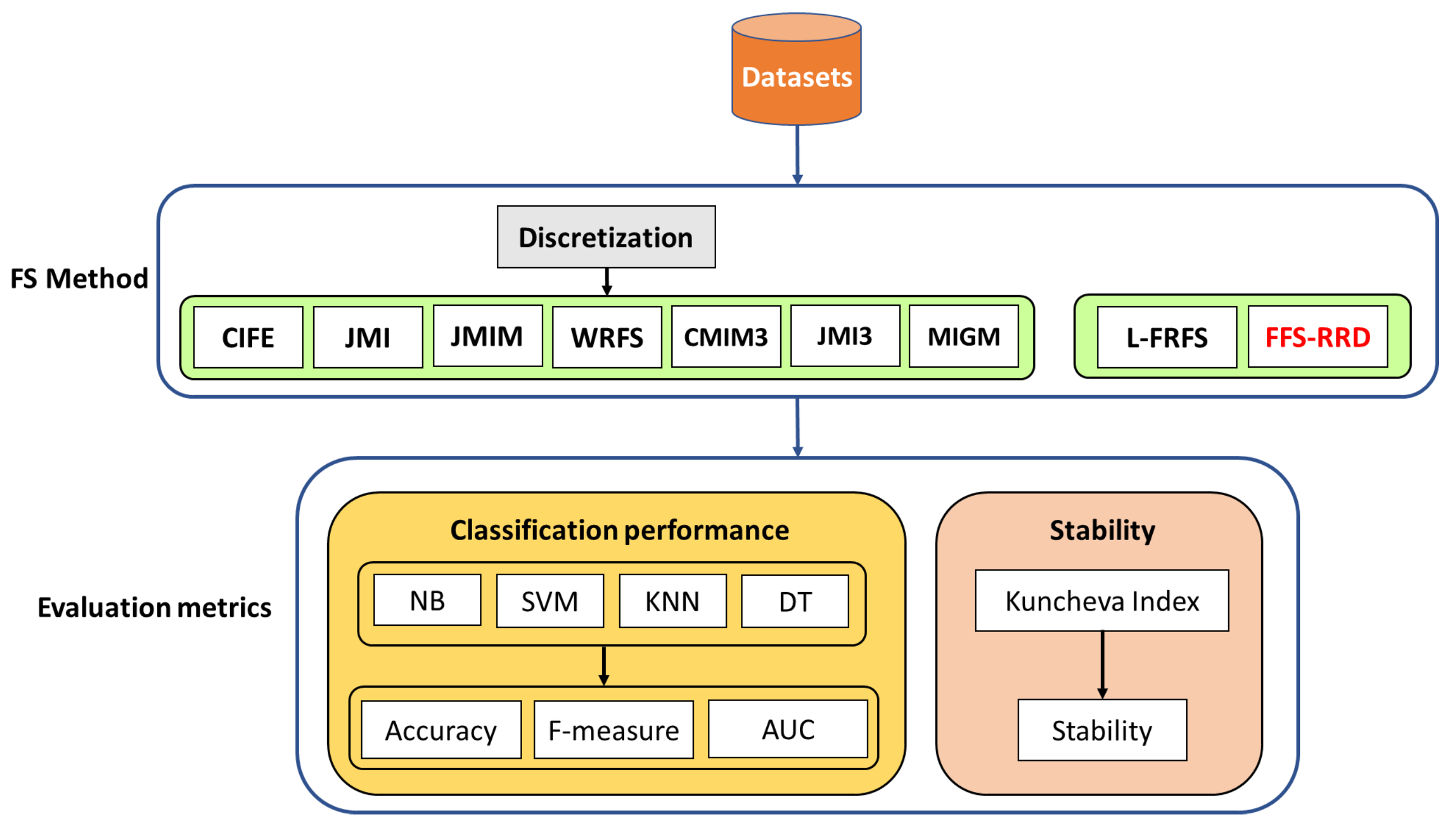
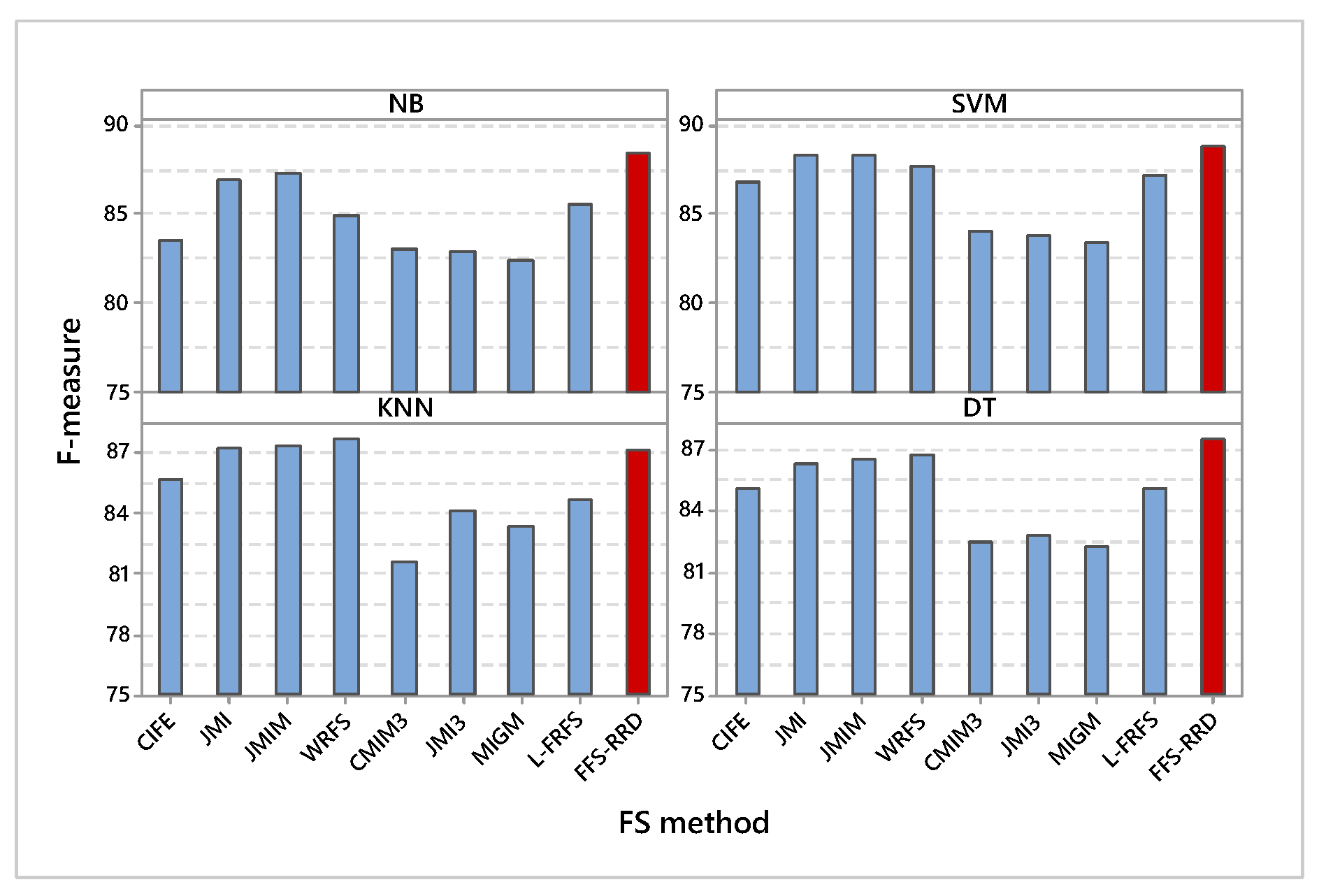
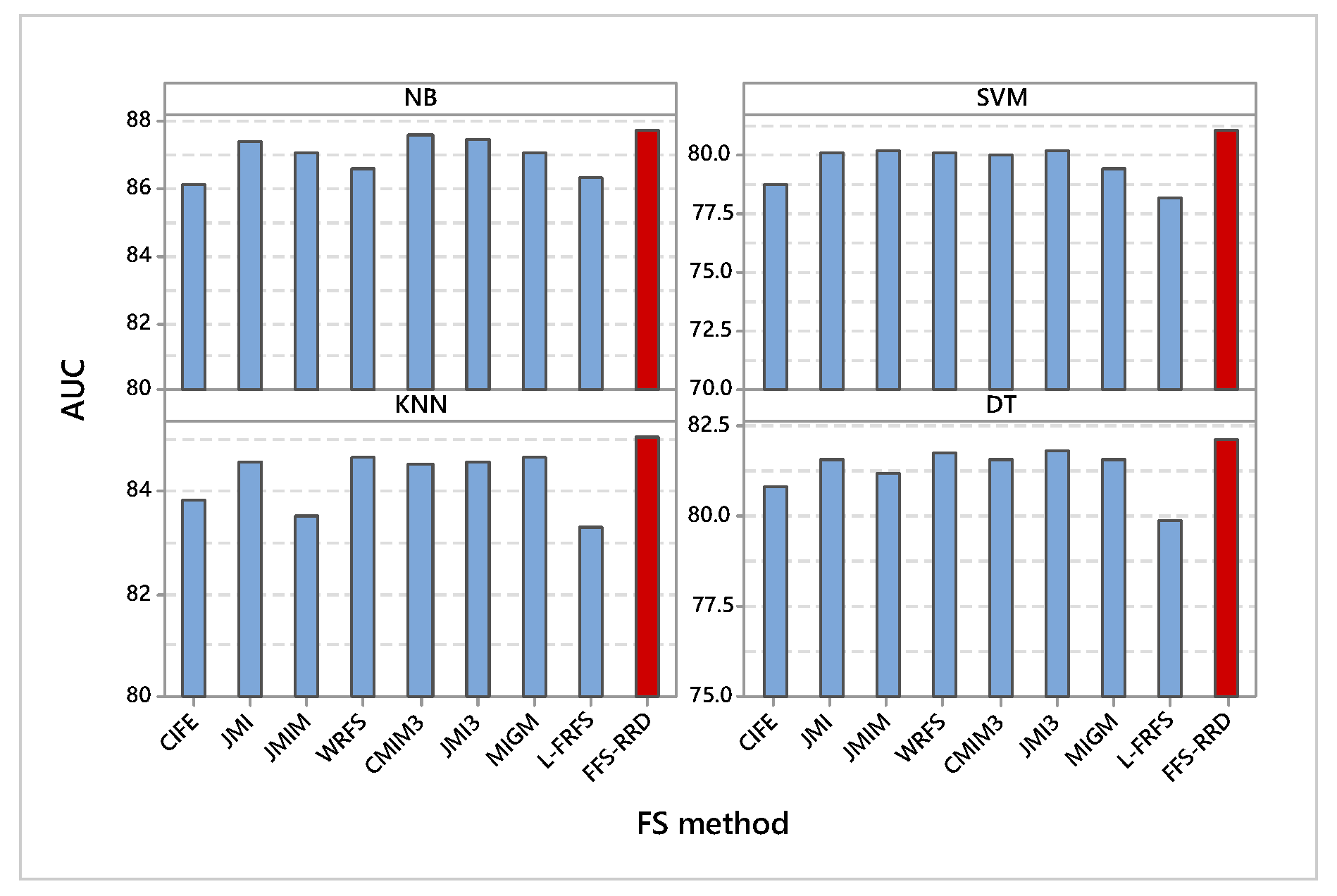
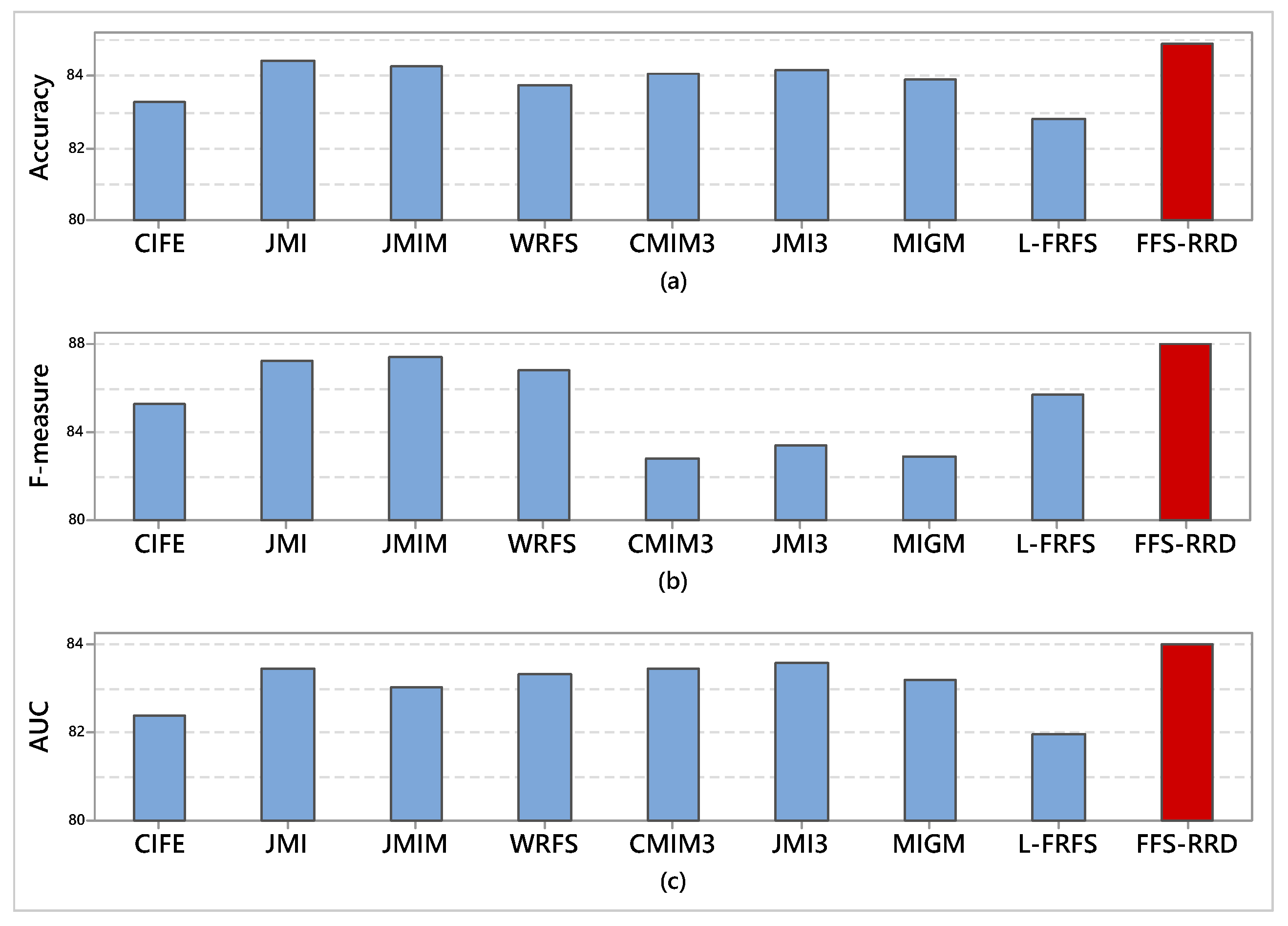
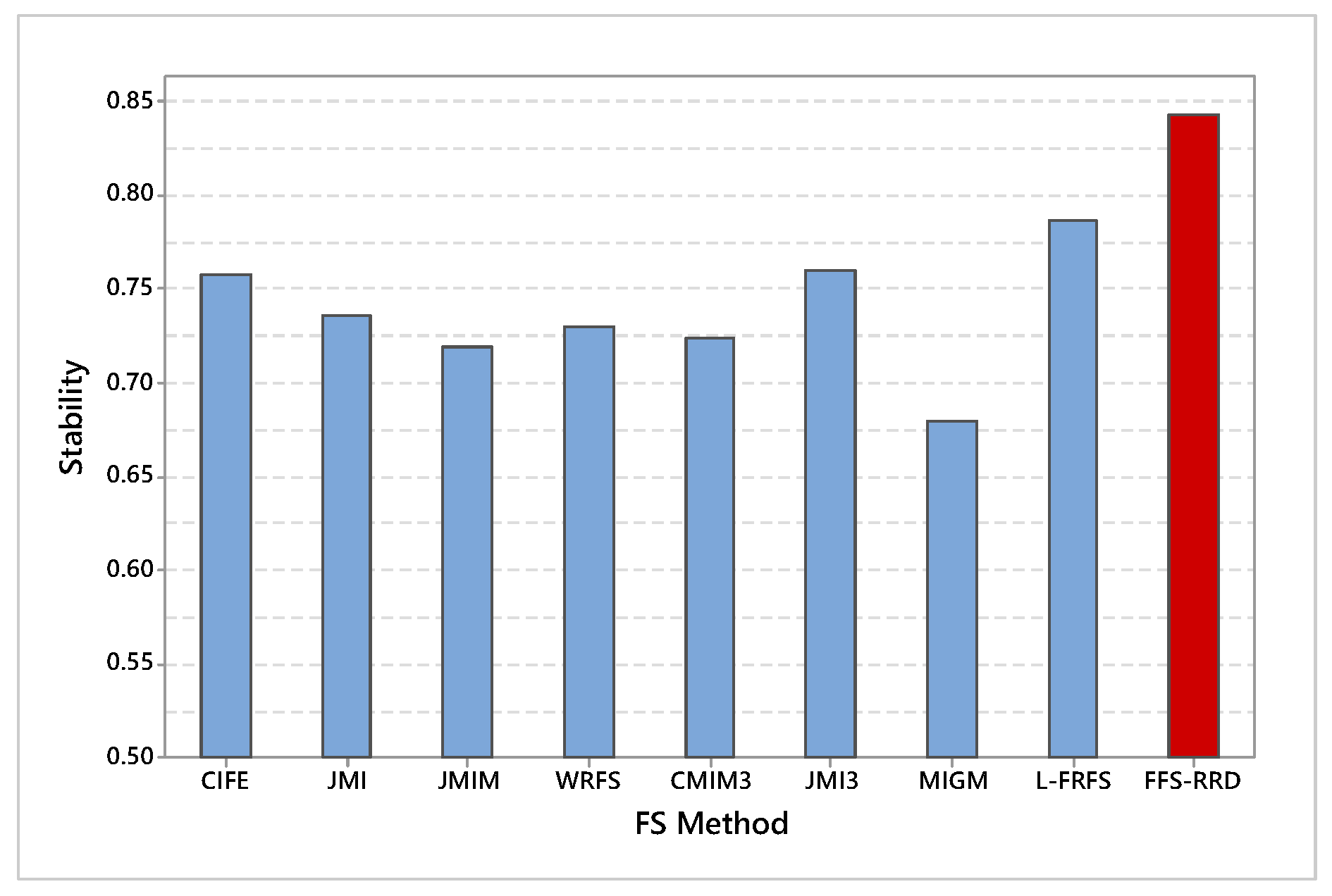
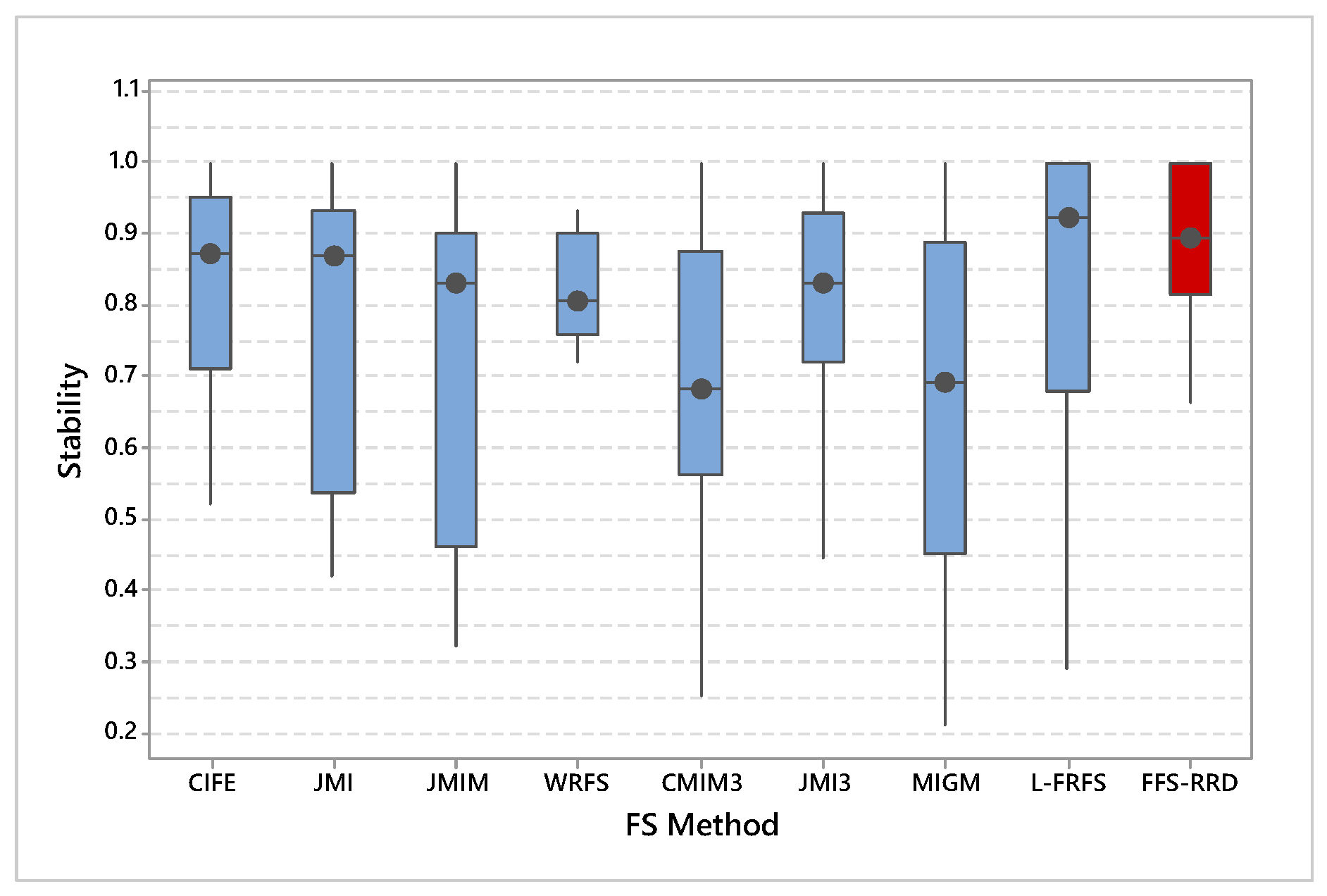
| C | ||
|---|---|---|
| 0.2 0.8 0.4 0.6 0.2 | 0.1 0.5 0.3 0.4 0.1 | 1 0 1 0 1 |
| Dataset | Brief | # Instances | # Features | # Classes |
|---|---|---|---|---|
| Breast Cancer Wisconsin (Prognostic) | BCW Prognostic | 198 | 33 | 2 |
| Breast Cancer Wisconsin (Diagnostic) | BCW Diagnostic | 569 | 31 | 2 |
| Climate Model Simulation Crashes | CMSC | 540 | 18 | 2 |
| Credit Approval | Credit Approval | 690 | 15 | 2 |
| Dermatology | Dermatology | 336 | 34 | 6 |
| Diabetic Retinopathy Debrecen | DRD | 1151 | 19 | 2 |
| Fertility | Fertility | 100 | 9 | 2 |
| Statlog (Heart) | Heart | 270 | 13 | 2 |
| Ionosphere | Ionosphere | 351 | 34 | 2 |
| Iris | Iris | 150 | 4 | 3 |
| Libras Movement | Libras Movement | 360 | 90 | 15 |
| QSAR biodegradation | QSAR | 1055 | 41 | 2 |
| Zoo | Zoo | 101 | 16 | 7 |
| Ref. | FS Group | FS Method | Discriminative Ability | |
|---|---|---|---|---|
| Individually | Dependency | |||
| [43] | Probability-based | CIFE | ✓ | |
| [25] | JMI | ✓ | ||
| [27] | JMIM | ✓ | ||
| [29] | WRFS | ✓ | ||
| [44] | CMIM3 | ✓ | ||
| [44] | JMI3 | ✓ | ||
| [45] | MIGM | ✓ | ||
| [16] | Fuzzy-based | L-FRFS | ✓ | |
| Proposed | FFS-RRD | ✓ | ✓ | |
| Dataset | CIFE | JMI | JMIM | WRFS | CMIM3 | JMI3 | MIGM | L-FRFS | FFS-RRD |
|---|---|---|---|---|---|---|---|---|---|
| BCW Prognostic | 73.9 | 69.5 | 73.8 | 65.4 | 68.6 | 68.8 | 67.7 | 71.3 | 69.8 |
| BCW Diagnostic | 92.0 | 93.4 | 93.4 | 93.6 | 93.2 | 92.4 | 92.9 | 85.9 | 93.6 |
| CMSC | 91.9 | 93.8 | 91.9 | 94.1 | 93.6 | 92.8 | 93.8 | 93.7 | 93.8 |
| Credit Approval | 85.6 | 83.5 | 83.7 | 86.9 | 82.4 | 83.7 | 84.8 | 76.8 | 85.4 |
| Dermatology | 96.1 | 93.9 | 95.3 | 93.1 | 98.0 | 94.6 | 95.3 | 96.2 | 96.1 |
| DRD | 57.6 | 60.3 | 57.6 | 57.5 | 57.7 | 60.6 | 60.3 | 57.6 | 57.5 |
| Fertility | 87.9 | 87.9 | 88.0 | 88.0 | 88.0 | 88.0 | 87.9 | 88.0 | 88.0 |
| Heart | 80.1 | 83.0 | 81.0 | 84.1 | 83.0 | 83.9 | 80.1 | 75.1 | 81.5 |
| Ionosphere | 77.0 | 82.6 | 86.2 | 80.8 | 84.8 | 84.8 | 77.4 | 89.8 | 89.0 |
| Iris | 94.6 | 94.6 | 94.6 | 94.6 | 93.5 | 93.5 | 93.5 | 95.0 | 95.0 |
| Libras Movement | 51.4 | 61.7 | 60.8 | 50.5 | 59.0 | 59.0 | 59.4 | 61.0 | 60.0 |
| QSAR | 78.2 | 78.7 | 77.1 | 78.5 | 78.7 | 78.1 | 77.6 | 77.7 | 80.0 |
| Zoo | 94.2 | 95.1 | 96.0 | 96.0 | 96.1 | 96.0 | 96.9 | 93.5 | 94.9 |
| Average | 81.6 | 82.9 | 83.0 | 81.8 | 82.8 | 82.8 | 82.1 | 81.7 | 83.4 |
| Dataset | CIFE | JMI | JMIM | WRFS | CMIM3 | JMI3 | MIGM | L-FRFS | FFS-RRD |
|---|---|---|---|---|---|---|---|---|---|
| BCW Prognostic | 76.3 | 76.8 | 77.9 | 76.3 | 76.4 | 77.7 | 76.6 | 76.3 | 77.5 |
| BCW Diagnostic | 96.3 | 97.3 | 97.3 | 97.5 | 96.9 | 95.0 | 95.6 | 88.4 | 96.3 |
| CMSC | 91.5 | 92.0 | 91.5 | 93.2 | 91.9 | 91.6 | 91.9 | 92.1 | 91.9 |
| Credit Approval | 85.5 | 85.5 | 85.5 | 85.5 | 85.5 | 85.5 | 85.5 | 73.7 | 85.5 |
| Dermatology | 95.8 | 95.5 | 95.8 | 94.2 | 98.2 | 96.8 | 95.7 | 96.8 | 96.5 |
| DRD | 68.0 | 67.2 | 68.0 | 67.7 | 67.5 | 67.0 | 67.2 | 68.0 | 67.7 |
| Fertility | 88.0 | 88.0 | 88.0 | 88.0 | 88.0 | 88.0 | 88.0 | 88.0 | 88.0 |
| Heart | 79.7 | 84.3 | 84.3 | 84.2 | 81.3 | 83.7 | 79.7 | 76.3 | 82.5 |
| Ionosphere | 76.6 | 79.0 | 78.5 | 81.2 | 81.7 | 82.9 | 78.0 | 86.7 | 87.6 |
| Iris | 95.7 | 95.7 | 95.7 | 95.9 | 93.9 | 93.9 | 93.9 | 94.5 | 95.0 |
| Libras Movement | 72.2 | 76.1 | 74.7 | 67.6 | 75.5 | 74.9 | 74.5 | 76.5 | 75.3 |
| QSAR | 84.2 | 84.3 | 84.5 | 82.3 | 84.2 | 83.7 | 84.4 | 83.8 | 84.1 |
| Zoo | 92.8 | 95.3 | 88.7 | 93.3 | 93.9 | 89.5 | 94.1 | 92.0 | 95.3 |
| Average | 84.8 | 85.9 | 85.4 | 85.1 | 85.8 | 85.4 | 85.0 | 84.1 | 86.4 |
| Dataset | CIFE | JMI | JMIM | WRFS | CMIM3 | JMI3 | MIGM | L-FRFS | FFS-RRD |
|---|---|---|---|---|---|---|---|---|---|
| BCW Prognostic | 75.2 | 75.0 | 77.1 | 76.6 | 73.5 | 74.1 | 76.9 | 74.0 | 77.0 |
| BCW Diagnostic | 93.3 | 93.5 | 97.1 | 95.4 | 95.1 | 94.6 | 95.2 | 87.5 | 94.8 |
| CMSC | 90.1 | 92.3 | 90.1 | 92.0 | 90.9 | 92.4 | 92.6 | 93.4 | 93.0 |
| Credit Approval | 84.7 | 83.9 | 85.1 | 85.5 | 84.4 | 85.3 | 85.1 | 76.4 | 84.6 |
| Dermatology | 95.0 | 95.9 | 95.6 | 93.7 | 97.7 | 96.9 | 96.1 | 96.1 | 96.3 |
| DRD | 64.3 | 63.7 | 64.3 | 64.1 | 62.3 | 63.7 | 63.6 | 64.7 | 64.1 |
| Fertility | 88.7 | 88.7 | 87.2 | 86.7 | 84.0 | 90.5 | 88.7 | 85.0 | 89.4 |
| Heart | 77.7 | 79.1 | 79.1 | 81.7 | 79.3 | 77.7 | 77.6 | 71.7 | 78.2 |
| Ionosphere | 81.8 | 80.9 | 80.3 | 83.0 | 82.3 | 83.3 | 83.5 | 82.7 | 84.2 |
| Iris | 93.9 | 93.9 | 93.9 | 93.9 | 91.8 | 91.8 | 91.8 | 92.7 | 92.7 |
| Libras Movement | 70.7 | 76.8 | 77.9 | 70.4 | 77.1 | 74.7 | 78.3 | 75.8 | 78.3 |
| QSAR | 84.0 | 84.7 | 83.3 | 81.5 | 83.8 | 84.4 | 83.6 | 82.5 | 83.0 |
| Zoo | 90.1 | 94.1 | 91.6 | 93.1 | 92.1 | 92.1 | 91.2 | 89.7 | 94.3 |
| Average | 83.8 | 84.8 | 84.8 | 84.4 | 84.2 | 84.7 | 84.9 | 82.5 | 85.4 |
| Dataset | CIFE | JMI | JMIM | WRFS | CMIM3 | JMI3 | MIGM | L-FRFS | FFS-RRD |
|---|---|---|---|---|---|---|---|---|---|
| BCW Prognostic | 73.8 | 73.7 | 73.1 | 72.5 | 72.8 | 73.0 | 73.0 | 76.6 | 73.2 |
| BCW Diagnostic | 93.7 | 94.5 | 94.1 | 94.2 | 94.0 | 93.5 | 93.5 | 88.6 | 94.6 |
| CMSC | 89.6 | 91.2 | 89.6 | 90.3 | 91.4 | 91.2 | 91.3 | 91.3 | 91.6 |
| Credit Approval | 85.5 | 85.5 | 85.7 | 86.3 | 84.8 | 85.7 | 85.3 | 75.3 | 86.3 |
| Dermatology | 93.6 | 92.3 | 92.2 | 91.3 | 93.5 | 94.1 | 92.5 | 94.3 | 94.9 |
| DRD | 68.0 | 65.8 | 68.0 | 67.7 | 65.0 | 66.8 | 65.9 | 67.7 | 67.6 |
| Fertility | 87.1 | 87.1 | 87.1 | 87.6 | 86.6 | 86.6 | 87.1 | 87.5 | 87.5 |
| Heart | 73.9 | 80.3 | 81.3 | 80.6 | 76.3 | 77.6 | 74.0 | 74.3 | 75.5 |
| Ionosphere | 88.4 | 88.4 | 88.4 | 89.7 | 88.8 | 88.4 | 88.0 | 88.6 | 89.0 |
| Iris | 90.8 | 90.8 | 90.8 | 90.8 | 91.9 | 91.9 | 91.9 | 91.7 | 91.7 |
| Libras Movement | 60.4 | 66.0 | 65.6 | 61.3 | 64.7 | 64.3 | 67.5 | 66.0 | 66.4 |
| QSAR | 83.2 | 83.7 | 82.5 | 83.5 | 82.9 | 83.5 | 82.3 | 82.3 | 82.9 |
| Zoo | 91.9 | 94.0 | 92.3 | 92.9 | 93.4 | 92.1 | 94.1 | 96.0 | 97.1 |
| Average | 83.1 | 84.1 | 83.9 | 83.7 | 83.5 | 83.7 | 83.6 | 83.1 | 84.5 |
© 2020 by the authors. Licensee MDPI, Basel, Switzerland. This article is an open access article distributed under the terms and conditions of the Creative Commons Attribution (CC BY) license (http://creativecommons.org/licenses/by/4.0/).
Share and Cite
Salem, O.A.M.; Liu, F.; Chen, Y.-P.P.; Chen, X. Ensemble Fuzzy Feature Selection Based on Relevancy, Redundancy, and Dependency Criteria. Entropy 2020, 22, 757. https://doi.org/10.3390/e22070757
Salem OAM, Liu F, Chen Y-PP, Chen X. Ensemble Fuzzy Feature Selection Based on Relevancy, Redundancy, and Dependency Criteria. Entropy. 2020; 22(7):757. https://doi.org/10.3390/e22070757
Chicago/Turabian StyleSalem, Omar A. M., Feng Liu, Yi-Ping Phoebe Chen, and Xi Chen. 2020. "Ensemble Fuzzy Feature Selection Based on Relevancy, Redundancy, and Dependency Criteria" Entropy 22, no. 7: 757. https://doi.org/10.3390/e22070757
APA StyleSalem, O. A. M., Liu, F., Chen, Y.-P. P., & Chen, X. (2020). Ensemble Fuzzy Feature Selection Based on Relevancy, Redundancy, and Dependency Criteria. Entropy, 22(7), 757. https://doi.org/10.3390/e22070757






